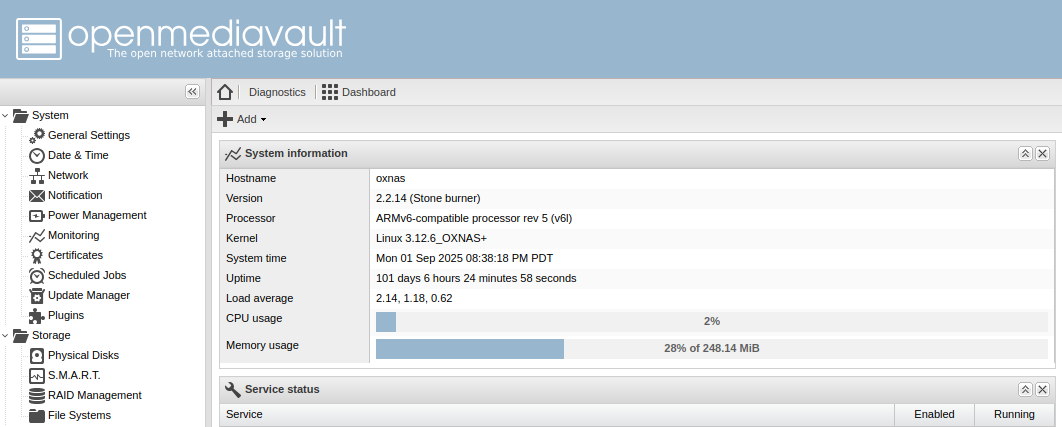7 websites, Jellyfin for 6 people, Nextcloud, CRM for work, email server for 3 domains, NAS, and probably some stuff I’ve forgotten on a $4 computer from a tiny thrift store in BFE Kansas. I’d love to upgrade, but I’m always just filled with joy whenever I think of that little guy just chugging along.
Hell yeah, keep chugging little guy 🤘
Heck yeah
Which CRM please?
Interested in how it does jellyfin, decent GPU or something else?
It does fine. It’s an i5-6500 running CPU transcoding only. Handles 2-3 concurrent 1080p streams just fine. Sometimes there’s a little buffering if there’s transcoding going on. I try to keep my files at 1080p for storage reasons though. This thing’s not going to handle 4k transcoding very well, but it does okay if you don’t expect too much from it.
I’m skeptical that you are doing much video transcoding anyway. 1080p is supported on must devices now, and h264 is best buddies with 1080p content - a codec supported even on washing machines. Audio may be transcoded more often.
Most of my content is h265 and av1 so I assume they are also facing a similar issue. I usually use the jellyfin app on PC or laptop so not an issue but my family members usually use the old TV which doesn’t support it.
AV1 is definitely a showstopper a lot of the time indeed. H265 I would expect to see more on 2k or 4k content (though native support is really high anyway). My experience so far has been seeing transcoding done only becuase the resolution is unsupported when I try watching 4k videos on an older 1080p only chromecast.
What do you mean by showstopper? I only encode my shows into AV1/opus and I never had any transcoding happening on any of my devices.
It’s well supported on any recent Browser compared to x264/x265… specially 10bit encodes. And software decoding is nearly present on any recent device.
Dunno about 4k though, I haven’t the necessary screen resolution to play any 4k content… But for 1080p, AV1 is the way to go IMO.
- Free open/source
- Any browser supported
- Better compression
- Same objective quality with lower bitrate
- A lot of cool open source project arround AV1
It has it’s own quirks for sure (like every codec) but it’s far from a bad codec. I’m not a specialist on the subject but after a few months of testing/comparing/encoding… I settled with AV1 because it was comparative better than x264/x265.
Showstopper in the sense that it may not play natively and require transcoding. While x264 has pretty much universal support, AV1 does not… at least not on some of my devices. I agree that it is a good encoder and the way forward but its not the best when using older devices. My experience has been with Chromecast with Google TV. Looks like google only added AV1 support in their newest Google TV Streamer (late 2024 device).
Not a huge amount of transcoding happening, but some for old Chromecasts and some for low bandwidth like when I was out of the country a few weeks ago watching from a heavily throttled cellular connection. Most of my collection is h264, but I’ve got a few h265 files here and there. I am by no means recommending my setup as ideal, but it works okay.
Absolutely, whatever works for you. I think its awesome to use the cheapest hardware possible to do these things. Being able to use a media server without transcoding capabilities? Brilliant. I actually thought you’d probably be able to get away with no transcoding at all since 1080p has native support on most devices and so does h264. In the rare cases, you could transcode beforehand (like with a script whenever a file is added) so you’d have an appropriate format on hand when needed.
Just down load more ram capacity. It the button right under the down load more ram button.
I run a local LLM on my gaming computer thats like a decade old now with an old 1070ti 8GB VRAM card. It does a good job running mistral small 22B at 3t/s which I think is pretty good. But any tech enthusiast into LLMs look at those numbers and probably wonder how I can stand such a slow token speed. I look at their multi card data center racks with 5x 4090s and wonder how the hell they can afford it.
Does this count ARMv6 256MB RAM running OpenMediaVault…hmm I have to fix my clock. LOL


N…not quite…
I’m sure a lot of people’s self hosting journey started on junk hardware… “try it out”, followed by “oh this is cool” followed by “omg I could do this, that and that” followed by dumping that hand-me-down garbage hardware you were using for something new and shiny specifically for the server.
My unRAID journey was this exactly. I now have a 12 hot/swap bay rack mounted case, with a Ryzan 9 multi core, ECC ram, but it started out with my ‘old’ PC with a few old/small HDDs
People in this thread have very interesting ideas of what “shit hardware” is
My cluster ranges from 4th gen to 8th gen Intel stuff. 8th gen is the newest I’ve ever had (until I built a 5800X3D PC).
I’ve seen people claiming 9th gen is “ancient”. Like…ok moneybags.
My 9th gen intel is still not the bottleneck of my 120hz 4K/AI rig, not by a longshot.
Testing federation from my shit hardware… 😅
Looks like it works! Congrats!
Not seeing other comments… but see this over at .world
Maybe a more reasonable question: Is there anyone here self-hosting on non-shit hardware? 😅
I’m happy with my little N100
Rehabilitated HP z440 workstation, checking in! Popped in a used $20 e5-2620v4 xeon CPU and 64gb of RAM and it sails for my use cases. TrueNAS as the base OS and a TalOS k8’s cluster in a VM to handle apps. Old but gold.
2 GB RAM rasp pi 4 :))
It’s getting up there in years but I’m running a Dell T5610 with 128GB RAM. Once I start my new job I might upgrade cause it’s having issues running my MC server.
10400F running my NAS/Plex server and raspberry pi 5 running PiHole
I have pi-hole on my Mac mini using docker but I stopped using it, it makes some things super laggy to load
Interesting, I haven’t had any issues with things loading with mine, maybe it’s your adlists causing issues? Try disabling some, there might be false positives in there giving you issues
Me using Threadripper 7960X and R5 6600H for my servers: 🤭
Fuck ive been dealing with that + max RAM speed limitations for a month.
I was for a while. Hosted a LOT of stuff on an i5-4690K overclocked to hell and back. It did its job great until I replaced it.
Now my servers don’t lag anymore.
EDIT: CPU usage was almost always at max. I was just redlining that thing for ~3 years. Cooling was a beefy Noctua air cooler so it stayed at ~60 C. An absolute power house.
4 gigs of RAM is enough to host many singular projects - your own backup server or VPN for instance. It’s only if you want to do many things simultaneously that things get slow.
deleted by creator
The beauty of self hosting is most of it doesn’t actually require that much compute power. Thus, it’s a perfect use for hardware that is otherwise considered absolutely shit. That hardware would otherwise go in the trash. But use it to self host, and in most cases it’s idle most of the time so it doesn’t use much power anyway.
Enterprise level hardware costs a lot, is noisy and needs a dedicated server room, old laptops cost nothing.
I got a 1U rack server for free from a local business that was upgrading their entire fleet. Would’ve been e-waste otherwise, so they were happy to dump it off on me. I was excited to experiment with it.
Until I got it home and found out it was as loud as a vacuum cleaner with all those fans. Oh, god no…
I was living with my parents at the time, and they had a basement I could stick it in where its noise pollution was minimal. I mounted it up to a LackRack.
Since moving out to a 1 bedroom apartment, I haven’t booted it. It’s just a 70 pound coffee table now. :/
Not anymore. My main self-hosting server is an i7 5960x with 32GB of ECC RAM, RTX 4060, 1TB SATA SSD, and 6x6TB 7200RPM drives.
I did used to host some services on like a $5 or $10 a month VPS, and then eventually a $40 a month dedi, though.
What do you use the 4060 for?
I use it for Plex/Jellyfin, it’s the cheapest NVIDIA GPU that supports both AV1 encoding and decoding, even though Plex doesn’t support AV1 yet IIRC it’s still more futureproof that way. I picked it up for like around $200 on a sale, it was well worth it IMO.
Yeah, not here either. I’m now at a point where I keep wanting to replace my last host thats limited to 16GB. All the others - at least the ones I care about RAM on - all support 64GB or more now.
64GB would be a nice amount of memory to have. I’ve been okay with 32GB so far thankfully.









